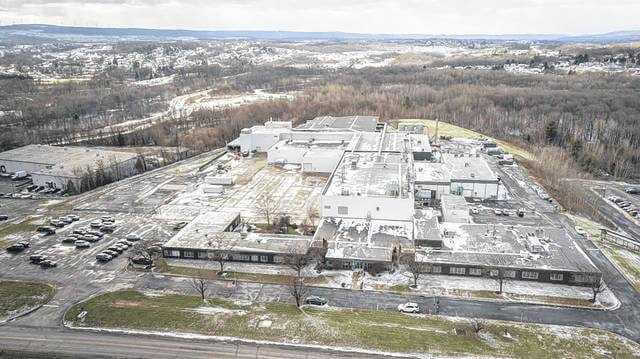
Duryea, Luzerne County, PA -
Fifty years ago, SCHOTT established a foothold on the North American continent in Duryea located in Northeastern Pennsylvania.
The firm had a long reputation as a manufacturer of precision optical glass used in the world's finest optics, and the U.S. military had often expressed interest in a domestic source for high quality glasses required for defense purposes.
The summer of 1969 was notable for several significant events, including the moon landing and the Woodstock Festival of Peace and Music; Sesame Street debuted, and Richard Nixon was sworn in as president. Amid these historic happenings, SCHOTT North America opened its factory in Duryea.
The firm has grown i size and stature from 55,000 square feet to more than 200,000 square feet today and from less than $2 million to more than $50 million in sales over that time span. July 1, 1969 marked the first optical glass melt at the new factory. Since then, many developments have fostered growth and stature within the local and optical communities. Three keys led to the establishment and subsequent growth of the firm:
• The foresight of SCHOTT's management in Germany to act on the obvious demand for a US presence at the urging of the United States military.
• The support of the local business community, especially the Greater Pittston Chamber of Commerce, in securing and preparing the Duryea site for construction of the factory.
• The availability of a skilled and willing local workforce.
SCHOTT had long enjoyed a reputation for manufacturing precision optical glass used in the world's finest optics, and the U.S. Air Force was interested in securing domestic production of this key material. The realization of this came together with the Incorporation of Schott Optical Glass Inc. in 1967. Construction of the factory commenced in 1968 and continued through summer 1969. The original factory was a miniature version of the firm's parent company in Mainz, Germany and was outfitted to produce the highest quality optical glass.
Then, in 1970, SCHOTT acquired the business that would become its Ophthalmic Division from PPG Industries and instantly became one of the world's leading manufacturers of glass for spectacle lenses. This led to a number of innovations in the Duryea R&D laboratory, including lightweight glasses for thin eyeglass lenses and colored glasses for popular sunglass brands.
Research and development has always been a core ingredient for the site's growth. In fact, Industrial Research Magazine has recognized the company for its developments in the fields of fiber optics, ophthalmic glass, and laser glass. These early successes formed the impetus to build a state-of-the-art research and development wing in 1982. Today, in addition to supporting the SCHOTT Advanced Optics Business Unit, this laboratory also serves all SCHOTT's North American facilities.
Initial production consisted of both continuous and discontinuous melting operations. Recently, glass melting has been restricted to discontinuous, individual batch melting processes, while glass processing has been expanded to include precision finishing and coating operations.
The markets for laser glass and infrared transmitting glass are primarily located in the United States, hence SCHOTT has selected the Duryea site as the location for manufacturing these unique products. Both product lines form an integral part in the continuing growth plans for SCHOTT's Advanced Optics Business Unit.
Laser glass, in particular, has a long history of fostering innovation within the international optical community. SCHOTT has supplied glasses for the major research lasers in the United States and worldwide. The first laser glasses were developed in the early 1960s for powerful lasers being developed by the U.S. government. With names like Shiva, Novette and Nova, the programs invoked mythical names. They culminated in the construction of the National Ignition Facility, which is simultaneously the world's largest laser and precision optical instrument. The goal of all of these programs was to achieve nuclear fusion by using laser beams to confine reactions within the target chamber. The ultimate aim is to produce power, the by-product of which is ordinary water.
The firm has also developed laser glasses for other applications, such as range finders and medical lasers used in ophthalmic and cosmetic fields. The primary active “ingredients” for these products are the rare earths, neodymium and erbium.
Compared to laser glasses, which have a long history at SCHOTT Duryea, infrared transmitting glasses are a relatively recent addition to the site's product offering. These glasses, primarily from a glass family called “chalcogenide” glasses, are remarkable for excellent light transmission in the infrared region of the optical spectrum. Such light rays are invisible to the human eye. However, this invisible “light” is important in the fields of sensors and photography.
Early glass fabrication was limited to rudimentary cutting, grinding, and polishing, primarily for inspection purposes. Today, the facility possesses ultra-modern equipment capable of producing precision polished and coated surfaces. This is achieved using various cutting, grinding, drilling, CNC machining, polishing and coating equipment.
The company manufactures and processes pieces of glass that weigh anywhere from a pound or two to mammoth pieces weighing several tons and requiring specialized lifting and transporting equipment, such as overhead cranes and high capacity lifts.
At various times during its 50-year history, SCHOTT Site Duryea has focused on many areas of activity. Despite technological advances and maturing of markets, classical optics - glass for lenses, prisms and windows - remains an important part of the product portfolio. The company has endured some bumps in the road, most notably a devastating fire that destroyed a significant portion of the plant in 2015. However, the few setbacks have served as incentives for positive developments of leading edge products and investments in personnel and equipment.
With 50 years of growth and success under its belt, the firm is poised for propulsion into the next fifty years of expansion and progress.
By David Schimmel - SCHOTT North America Inc.